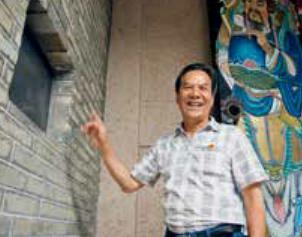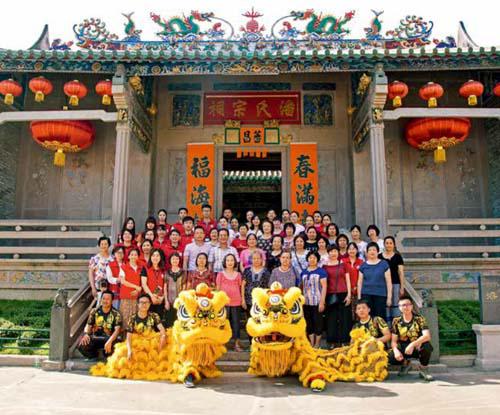HUAIDE Governing a Village with Passion
by Huang Liwei



From a small fishing village to a bustling international metropolis, Shenzhen has undergone enormous changes over the past 40 years since China implemented the reform and opening-up policy. During this exponential growth, changes have taken place not only in the administrative system but also in the ideas and concepts of social governance.
In May, journalists from China Pictorial visited Huaide Community of Fuyong Sub-district in Baoan District, Shenzhen. From the Huaide Ancestral Hall to the community service center and to the residentshomes, they learned about the dramatic changes that have occurred in yesterdays villages thanks to the administrative concepts of modern communities, featuring joint contribution and shared benefits.
First “Dividend Village”
Upon entering Huaide, known as the first “Dividend Village” in Fuyong Sub-district, visitors will see seniors pleasantly chatting under the trees or young mothers playing games with their kids in front of the ancient ancestral hall. The famous Shenzhen speed seems to slow way down there.
The history of Huaide, literally meaning “honoring ancestors benevolence,” can be traced back to the late Northern Song Dynasty (960-1127).
“Huaide has experienced tremendous changes thanks to favorable conditions in climate, geography and human capital,” asserts Fang Quanwei, who has served as a village official for over 20 years. “Over the past few years, we have capitalized on each favorable condition, including our countrys implementation of economic reform and opening-up policies, our geographical location near Hong Kong and Macao and our great vision and unity.”
Located in west-central Baoan District, Huaide links the north and the south of Shenzhen.
Before 1979, Huaide Village primarily earned a living from agricultural production, and its annual per capita income was less than 200 yuan. In 1983, it began seeking external investment and launched an industrial park.
In the early 1990s, Huaide Village received 30 million yuan in compensation for land acquisition. The village committee agreed that the money should be used for the long-term development of the collective economy.
Village officials went door-todoor to persuade those entitled to compensation to join in a long-term plan. Eventually, all villagers agreed to use the money to build an industrial park, which was named Cuigang No.1 Industrial Park and covered 47,000 square meters.
In the aftermath of the long stretch of rapid urbanization, village officials have maintained a keen eye for business development. They have continuously maintained and enjoyed appreciation of collective land resources and practiced large-scale land acquisition and construction of industrial areas. They hire outside professionals to enhance the development of commercial real estates, conduct intensive reform and are now in the process of building a modern central business district as well as an industrial park to boost the headquarters economy.
By 2017, the total assets of collectively owned enterprises in the village reached over 5 billion yuan, with profits of 460 million yuan and per capita dividends of 310,000 yuan, making Huaide the leading “Dividend Village” in the locality and the pride of its residents.
From Village to Community
In 2004, Shenzhen hastened its urbanization of rural areas and became the first city in China to eliminate the rural institution system and household registration.
Huaide Village was also restructured into Huaide Community, and its collective economy was transformed into a shareholding system. The villagers were elevated to community residents and shareholders.
The rapid advancement of industrialization and urbanization has spawned the “rampant” growth of villages such as Huaide. Problems such as real estate speculation, population influx, renovation and maintenance of dilapidated buildings, environmental sanitation, and disputes among neighbors have triggered concerns as to how the stable development of the entire community would be ensured.
Huaide people are again using their wisdom to lead the establishment of a unique pattern of modernized community governance.
According to Pan Jiaodong, Party chief of the community, two prominent features characterize Huaides community governance. Firstly, they increase the say of the communitys Party committee, which consolidates the Party committees core position. Secondly, they highlight service to the people and promote a pattern featuring joint contribution, joint governance and shared benefits.
Over the past few years, the communitys Party committee has made considerable achievements in governance. It set up the Common Homeland Construction Committee(CHCC), Property Management Association, and Volunteers Association in addition to various social organizations to take care of senior residents and provide education and training, cultural and sports entertainment, and neighborhood aid.
Since its founding, the CHCC has focused on addressing the most pressing issues in the community, hearing residents complaints and brainstorming solutions with all organizations and people from different groups to effectively handle conflicts and disputes in a timely manner.
Moreover, the community has carried out various charity activities to attract civic participation from the wealthy. The “Silver Hair” choir has attracted many seniors who love to sing. The youth basketball league provides young people with more activities. After-class child care services have solved the problem of the gap between the time when children get home from school and when parents get home from work.
“Our dreams are way past contentment,” smiled Pan Jiaodong. “Our final approach is to encourage everyone to make a difference alongside social progress.”
In accordance with the unified deployment of Baoan District, in 2017, Huaide was designated as a pilot community for the establishment of a governing system for modern communities.
Good Family Traditions
Huaide takes pride in its incomparable advantages, which include good traditions that have been handed down from generation to generation.
“Since the first settlement of the Pan clan, the people of Huaide have maintained graceful Confucian family traditions,” explains Pan Jiaodong. These family traditions and parental guides have been compiled into the Chronicles of Huaide Village, which has been disseminated through various forms such as songs, cultural works and inscriptions in the Pan Ancestral Hall. To this day, residents in the community have followed those traditions passionately.
Volunteering is another common practice in Huaide. The communitys Volunteers Association was established, and over 30 percent of local residents are engaged in community charity activities.
Since 2016, volunteers have provided vegetable-purchase services to the doorsteps of the elderly over the age of 70 living in the community. Over the past couple of years, the coverage of this voluntary service has evolved from 40 to 50 households to all local families with vulnerable people such as the elderly, the sick and the injured.
In recent years, many social work teams in Shenzhen have begun to open offices in local communities to work more professionally and efficiently.
Huaide has also launched a charitable care fund with 1.3 million yuan from local shareholding companies and more than 300,000 yuan from other organizations. The fund aims to help the poor, encourage advancement and support entrepreneurship.

